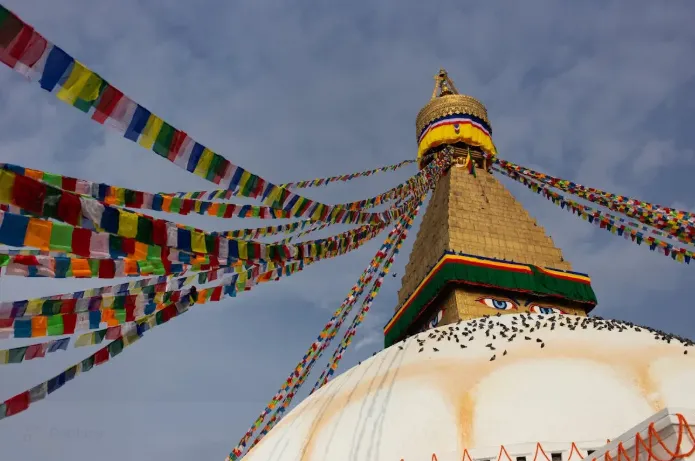Help Crestone Films bring
the wisdom traditions to global audiences.


Blog
Reviews

Exploring the Spiritual Depths of Tibetan Buddhism
Tibetan Buddhism is a rich and profound spiritual tradition that has fascinated people for centuries. With its deep philosophical teachings and vibrant practices, Tibetan Buddhism offers a unique perspective on life and spirituality. In this blog, we'll journey through the key aspects of Tibetan Buddhism and uncover the spiritual depths it offers to practitioners and seekers alike.

The Origins and History of Tibetan Buddhism
Tibetan Buddhism, known for its unique synthesis of Indian Buddhist teachings and indigenous Tibetan beliefs, began its journey in the 7th century CE. This integration resulted in a spiritual tradition rich in symbolism and ritual. Initially, Buddhism entered Tibet through the influence of Indian scholars and teachers who brought the teachings of the Buddha to the region. It was not until the early 8th century that Buddhism gained prominence through the efforts of key figures such as Guru Rinpoche, also known as Padmasambhava. He is credited with establishing a cohesive Buddhist community and adapting the teachings to resonate with the Tibetan way of life. As Buddhism intertwined with local traditions, it created a diverse and vibrant spiritual landscape that continues to thrive today.
One of the most intriguing aspects of Tibetan Buddhism is how it has absorbed the elements of pre-Buddhist traditions, such as Bon. This adaptability has allowed the teachings to flourish in the unique cultural and geographical context of the Himalayas. The historical journey of Tibetan Buddhism has seen the rise of several lineages, each with its distinct emphasis and interpretation of the Buddha's teachings. Over time, these lineages, including the Kagyu, Nyingma, Sakya, and Gelug schools, have contributed to the intricate tapestry that defines Tibetan Buddhism today. Each school upholds vital teachings and practices that guide its followers toward the ultimate goal of enlightenment.
Core Teachings and Philosophical Concepts
Central to Tibetan Buddhism are profound teachings that seek to liberate sentient beings from the shackles of samsara, the cyclical existence of suffering. At the core of these teachings is the Four Noble Truths, which provide a realistic framework to understand suffering and the path to transcend it. The first truth acknowledges the pervasive nature of suffering, while the subsequent truths explore the causes of suffering, the cessation of suffering, and the path leading to this cessation. Through practicing the Eightfold Path, which encompasses ethical conduct, mental discipline, and wisdom, practitioners aim to achieve liberation and attain Buddhahood.
Another pivotal teaching in Tibetan Buddhism is the concept of 'emptiness' or Shunyata. This is not mere nothingness but the realization that things lack inherent, independent existence. By understanding this concept, practitioners cultivate the wisdom that dismantles attachment and aversion, major obstacles on the path to enlightenment. Furthermore, Tibetan Buddhism places a strong emphasis on Bodhicitta, the compassionate aspiration to attain enlightenment for the benefit of all beings. This altruistic intention is nurtured through various practices, fostering a compassionate heart that transcends selfish desires.
Tibetan Buddhism also emphasizes the Lamrim or 'Stages of the Path', a structured approach to spiritual development. This comprehensive framework outlines incremental stages that guide practitioners from initial realization to advanced meditative practices leading to enlightenment. Rooted in the teachings of influential figures like Atiśa Dīpankara, the Lamrim serves as a practical guide for seekers, facilitating a step-by-step transformation of consciousness. By following these teachings, practitioners progressively deepen their understanding and compassion, experiencing profound shifts in consciousness.
The Role of Meditation and Mindfulness
Meditation is the bedrock of Tibetan Buddhist practice, nurturing mindfulness and insightful awareness that lead to spiritual realization. Through various meditative techniques, practitioners learn to navigate the complexities of the mind, unraveling layers of delusion and ignorance. Tibetan meditation practices often incorporate visualizations, mantra recitations, and the cultivation of focused awareness to develop a profound connection with one's inner essence. By calming the 'monkey mind', practitioners gain insight into the nature of reality and harness the transformative potential of the mind.
One significant aspect of meditation in Tibetan Buddhism is the practice of Chod, which involves "cutting through the ego" to dissolve self-centeredness. This practice uses visualizations and ritualistic elements to confront and transcend perceived dualities, leading to a direct experience of unity and compassion. Chod practitioners often employ sound, such as the beat of a drum or the melody of a bell, to facilitate the journey into the depths of consciousness.
Another essential meditative practice is Shamatha, or calm abiding meditation, which cultivates a stable and focused mind. By concentrating on the breath or an object, practitioners develop the mental clarity necessary for profound insight, or Vipassana, meditation. This dual practice of concentration and insight forms the cornerstone of Tibetan mindfulness, enabling practitioners to experience a tranquil mind and a heightened sense of awareness. Ultimately, these tools encourage individuals to embark on a journey of self-discovery, unraveling the layers of existence and revealing the boundless nature of the mind.
Significance of Rituals and Symbols
In Tibetan Buddhism, rituals and symbols serve as tangible expressions of profound spiritual teachings, bridging the gap between the temporal and the transcendental. Rituals such as the creation and dissolution of mandalas represent the impermanence of all phenomena, emphasizing the universal truth of change and interdependence. These intricate sand paintings, crafted with meticulous precision, symbolize the cosmos and the enlightened mind, offering practitioners an opportunity to cultivate patience, focus, and a deeper understanding of their transient nature.
Prayer flags are another widely recognized symbol in Tibetan Buddhism. These vibrant, windblown flags carry prayers and blessings to all beings as they flutter in the breeze, promoting peace, compassion, and harmony. By hanging prayer flags in sacred spaces or places of natural beauty, practitioners participate in a collective intention that enhances the well-being of all sentient beings. Similarly, the use of prayer wheels, often inscribed with mantras, serves as a dynamic form of meditation, allowing practitioners to realize the transformative power of mindful acts. As the prayer wheel turns, the power of the mantras is believed to radiate positive energy, influencing the world around them.
Thangkas, detailed scroll paintings depicting deities, mandalas, or spiritual scenes, hold educational and meditative significance. Serving as focal points for meditation, these vibrant works of art invite practitioners to immerse themselves in the contemplative process, enhancing their connection with the symbolic meaning and teachings represented. Through engaging with these symbols, practitioners deepen their understanding of ultimate reality and strengthen their sense of devotion, using visual cues to bridge the realms of the mundane and the spiritual.
The Influence of Tibetan Buddhism on Western Thought
In the modern era, Tibetan Buddhism has transcended geographical boundaries to make a profound impact on Western spirituality and psychology. Its teachings on mindfulness and compassion have been embraced by many seeking holistic approaches to mental wellness and personal growth. By introducing the principles of interconnectedness and the transformative potential of compassion to a wider audience, Tibetan Buddhism has broadened perspectives on consciousness and the self.
Various Western thinkers and psychologists have integrated Tibetan Buddhist concepts into practices such as mindfulness-based cognitive therapy (MBCT) and mindful self-compassion, recognizing the benefits these teachings offer in healing stress, anxiety, and depression. Additionally, Tibetan Buddhist philosophy's emphasis on the impermanent nature of reality and the interconnectedness of all phenomena has inspired contemporary dialogues on environmental ethics and social justice, encouraging more compassionate and sustainable practices. The profound insights from Tibetan Buddhism continue to enrich both individual and societal growth, promoting a consciousness shift towards greater empathy and understanding.
The Enduring Wisdom of Tibetan Buddhism
Tibetan Buddhism is a profound and intricate spiritual tradition that continues to inspire and transform lives around the world. By embracing its teachings and practices, individuals can experience deep spiritual growth and enlightenment. Whether you're just starting your spiritual journey or are looking to deepen your practice, Tibetan Buddhism offers timeless wisdom and insights that can guide you towards a more meaningful and mindful life.
“Physically and psychically transformative.”
YOGA JOURNAL
“[THE LION'S ROAR] speaks with uncommon clarity on the nature
of Buddhist life and thought… An important, lasting monument.”
“[YANGSI] unfolds in a cinema verité style that
offers an absorbing, intimate glimpse into a
religious tradition, a culture and a remarkable life. ”
“Beautifully done, [BODHISATTVA]
is a charming, educational, uplifting treasure.”
LIGHT OF CONSCIOUSNESS MAGAZINE
“Astonishing.”
SPIRITUALITY AND PRACTICE
ONLINE MEDIA

© 2024 by Crestone Films
